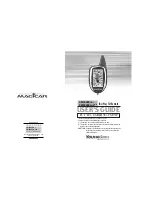
Section 7. Installation
follows: since all sub-scans have to complete before the task sequencer can
set the delay for the main scan, processing is delayed until this point (20 ms
in the above example). So more memory is required for the raw buffer space
for the sub-scan mode to run at the same speed as the non-sub-scan mode,
and there will be more delay before all the processing is complete for the
burst. The pipeline (the raw buffer) has to fill further before processing can
start.
•
One more way to view sub-scans is that they are a convenient (and only) way
to put a loop around a set of measurements.
SubScan() / NextSubScan
specifies a timed loop for so many times around a set of measurements that
can be driven by the task sequencer.
7.9.14.3 Measurement Rate: 601 to 2000 Hz
To measure at rates greater than 600 Hz,
VoltSE()
is switched into burst mode by
placing a dash (
-
) before argument in
SEChan
parameter argument and placing
alternate arguments in other parameters. Alternate arguments are described in the
table
Parameters for Analog Burst Mode
(p. 234).
In burst mode,
VoltSE()
dwells
on a single channel and measures it at rates up to 2000 Hz, as demonstrated in the
CRBasic example Measuring VoltSE() at 2000 Hz
.
The example program has an
86% duty cycle. That is, it makes measurements over only the leading 86% of the
scan. Note that burst mode places all measurements for a given burst in a single
variable array and stores the array in a single (but very long!) record in the data
table. The exact sampling interval is calculated as,
Tsample = 1.085069 * INT((SettleUSEC / 1.085069) + 0.5
where
SettleUSEC
is the sample interval (µs) entered in the
SettlingTime
parameter of the analog input instruction.
CRBasic Example 49.
Measuring VoltSE() at 2000 Hz
PipeLineMode
'<<<<Pipeline mode ensures precise timing of measurements.
Public
BurstSE(1735)
DataTable
(BurstSETable,1,-1)
Sample
(1735,BurstSE(),FP2)
EndTable
BeginProg
Scan
(1,Sec,10,0)
'
Measurement speed and count are set within VoltSE()
VoltSe
(BurstSE(),1735,mV2_5,-1,False,500,0,1.0,0)
CallTable
BurstSETable
NextScan
EndProg
Many variations of the burst program are possible. Multiple inputs can be measured, but one
burst is completed before the next begins. Caution dictates that a specific configuration be
thoroughly tested before deployment.
233
Summary of Contents for CR1000
Page 2: ......
Page 4: ......
Page 6: ......
Page 32: ......
Page 36: ......
Page 38: ......
Page 40: ......
Page 60: ...Section 4 System Quickstart Figure 16 PC200W View Line Graph 60 ...
Page 96: ......
Page 98: ...98 ...
Page 302: ......
Page 453: ...Section 8 Operation Figure 115 Using the Keyboard Display 453 ...
Page 456: ...Section 8 Operation Figure 118 Real Time Custom 456 ...
Page 457: ...Section 8 Operation 8 8 1 3 Final Memory Tables Figure 119 Final Memory Tables 457 ...
Page 458: ...Section 8 Operation 8 8 2 Run Stop Program Figure 120 Run Stop Program 458 ...
Page 460: ...Section 8 Operation Figure 122 File Edit 460 ...
Page 461: ...Section 8 Operation 8 8 4 PCCard Memory Card Display Figure 123 PCCard CF Card Display 461 ...
Page 478: ......
Page 506: ......
Page 536: ......
Page 636: ......
Page 642: ......
Page 644: ......
Page 676: ......
Page 677: ......
















































